

Lost in NYC: A Subway Adventure
CCSS-aligned Lesson Plan & Teacher’s Guide
TOON GRAPHICS FOR VISUAL READERS
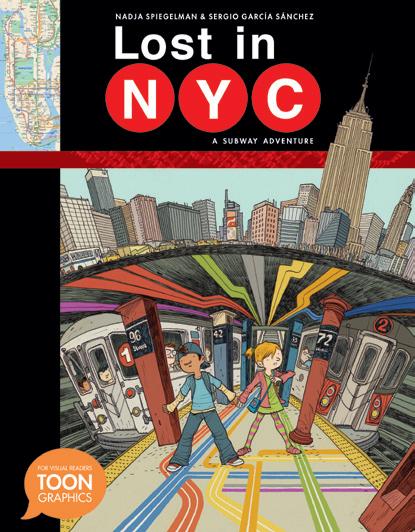
Lost in NYC: A Subway Adventure byNadjaSpiegelman &SergioGarcíaSánchez
A TOON Graphic
ISBN: 978-1-935179-81-8
Also available in Spanish
ISBN: 978-1-935179-85-6
© 2015 TOON Books, all rights reserved www.TOON-BOOKS.com
Please get in touch with your suggestions at mail@TOON-books.com
the t OON educati ON al O utreach team : Hsin Yu Chao, an illustrator and comic artist in her native Taiwan, is currently pursuing a master’s degree in Arts Administration at Teachers College, Columbia University. Chao has worked for numerous galleries as well as for the Metropolitan Museum of Art and the Solomon R. Guggenheim Museum.
Sasha Steinberg, who holds a BA in Comparative Literature from Vassar College and an MFA in Cartooning from the Center for Cartoon Studies, was awarded a Fulbright Fellowship to study political art in Russia.
TOON Graphics are comics and visual narratives that bring the text to life in a way that captures young readers’ imaginations and makes them want to read on—and read more.
The very economy of comic books necessitates the use of a reader’s imaginative powers. In comics, the images often imply rather than tell outright. Readers must learn to make connections between events to complete the narrative, helping them build their ability to visualize and to make “mental maps.” A comic book also gives readers a great deal of visual context that can be used to investigate the thinking behind the characters’ choices.
Pay attention to the artist’s choices
Look carefully at the artwork: it offers a subtext that at first is sensed only on a subliminal level by the reader and encourages rereading. It creates a sense
of continuity for the action, and it can tell you about the art, architecture, and clothing of a specific time period. It may present the atmosphere, landscape, and flora and fauna of another time or of another part of the world.
Facial expressions and body language reveal subtle aspects of characters’ personalities beyond what can be expressed by words.
READ AND REREAD!
Readers can compare comic book artists’ styles and evaluate how different authors get their point across in different ways. In investigating the author’s choices, a young reader begins to gain a sense of how all literary and art forms can be used to convey the author’s central ideas.
The world of TOON Books, TOON Graphics, and of comic book art is rich and varied. Making meaning out of reading with the aid of visuals may be the best way to become a lifelong reader, one who knows how to read for pleasure and for information—a reader who loves to read.


LITERACY IN THE 21ST CENTURY
In addition to providing students with the tools to master verbal literacy, each TOON Graphic offers a unique focus on visual learning. The 21st Century has seen a shift where literacy has been redefined to include visual literacy. Our unique lesson plans and teacher’s guides help instructors and students alike develop the vocabulary and framework necessary to discuss visual expressions, structure, and meaning in the classroom.
For schools that follow the ELA Common Core, TOON Graphics lesson plans offer examples of how to best utilize our books to satisfy a full range of state standards. The Common Core’s learning goals outline what a student should know and be able to do at the end of each grade, and were created to ensure that all students graduate from high school with the skills and knowledge necessary to succeed in college, career, and life, regardless of where they live. Though this book can be used in any grade, we focused this lesson plan on state standards for grades 4 and 5. Quenstions included in this guide fulfill the following standards:
CCSS.ELA-LITERACY. Reading: Literature (RL).4-5.1-10
Students build skills in reading and comprehending literature independently and proficiently.
CCSS.ELA-LITERACY. Reading: Informational Text (RI).4-5.1-10
Students build skills in reading and comprehending informational texts independently and proficiently.
CCSS.ELA-LITERACY. Speaking and Listening (SL).4-5.1
Students engage effectively in a range of collaborative discussions (one-onone, in groups, and teacher led) with diverse partenrs, building on others’ ideas and expressing their own clearly.
CCSS.ELA-LITERACY. Speaking and Listening (SL).4-5.2
Students summarize a text read aloud or information presented in diverse media and formats, including visually, quantitatively, and orally.
CCSS.ELA-LITERACY. Speaking and Listening (SL).4-5.4
Students report on a topic or present an opinion, sequencing ideas logically and usng appropriate facts and relevant, descriptive details to support main ideas or themes.
CCSS.ELA-LITERACY. Writing (W).4-5.1
Students write opinion pieces on topics or texts, supporting a point of view with reasons and information.
CCSS.ELA-LITERACY. Writing (W).4-5.2
Students write informative/explanatory texts to examine a topic and convey ideas and information clearly.
CCSS.ELA-LITERACY. Writing (W).4-5.7
Students conduct short research projects that build knowledge through investigation of different aspects of a topic.
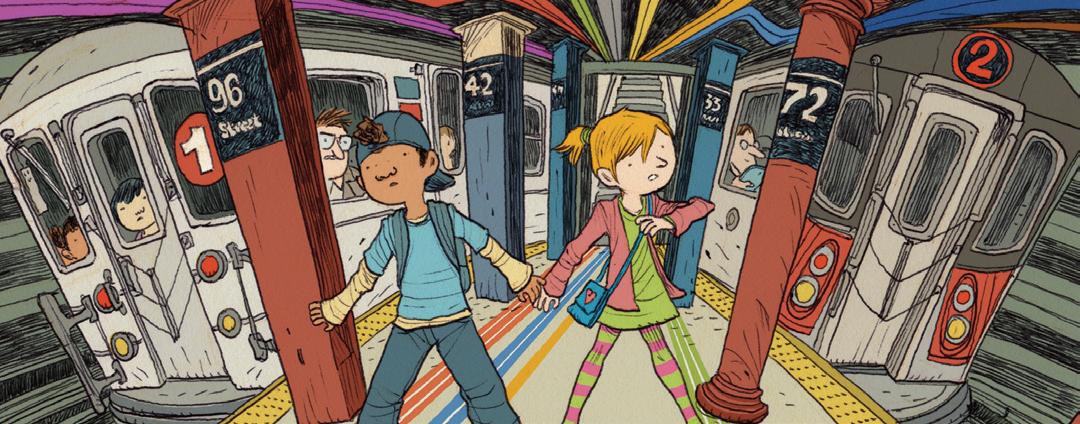
• Black = potential questions for course plans • Gray = feedback for teachers.
1
Verbal Expression
CCSS.ELA-LITERACY.RL.4.1
Refer to details and example in a text when explaining what the text says explicitly and when drawing inferences from the text.
CCSS.ELA-LITERACY.RL.4.2
Determine a theme of a story from details in the text; summarize the text.
CCSS.ELA-LITERACY.RL.4.3
*The standards listed on the right are fulfilled by every question in this section. Additional standardsmaybelisted in the gray sidebar on the left for particular units listed below.

Describe in depth a character, setting or event in a story, drawing on specific details in the text (e.g., a character’s thoughts, words, or actions).
CCSS.ELA-LITERACY.RL.5.1
Quote accurately from a text when explaining what the text says explicitly and when drawing inferences from the text.
CCSS.ELA-LITERACY.RL.5.2
Determine a theme of a story from details in the text, including how the characters in a story or drama respond to challenges; summarize the text.
CCSS.ELA-LITERACY.RL.5.3
Compare and contrast two or more characters, settings, or events in a story, drawing on specific details in the text (e.g., how characters interact).
Characters and Communication
u How would you describe Pablo and Alicia as characters? Pay special attention to the way they communicate and the things they say. How are they similar, how are they different? Explain your thoughts.
Alicia looks at things from a positive perspective. On page 7, when her classmate complains about Mondays, Alicia replies by saying, “No, it’s field trip day!” Alicia also values friendships and reflects on her feelings. Note that even after she is separated from Pablo (pages 28-29) she still thinks about him and worries.
Pablo, however, tends to avoid personal topics and talking about his feelings. Note how he gets upset when they are in a challenging situation (pages 24-25) and withdraws from the conversation (he often responds with “whatever”).
CCSS.ELA-LITERACY.RL.4.6
Compare and contrast the point of view from which different stories are narrated, including the difference between first- and third-person narrations.
CCSS.ELA-LITERACY.RL.5.6
Describe how a narrator’s or speaker’s point of view influences how events are described.

Guide students through a discussion about how personal backgrounds can have an impact on our communication styles and personalities. As a young person who has been moved around a lot, Pablo’s first impulse is to avoid getting too familiar with the city and his new classmates (page 25). Alicia may not have had such difficult experiences, so her relentless positivity may seem annoying or insensitive to Pablo. On page 25, when she insists that “everybody wants a friend,” she may fail to understand the complexity of Pablo’s experiences and feelings.
u Do the characters change over the course of the story? If so, how?
Pablo becomes more open and more expressive, beginning with his admission on page 30 that “I should have paid attention to Alicia.” Following that, he asks a stranger for help (page 30), admits he is feeling lonely (page 31), expresses affection for Alicia (page 35, “there’s my friend”), accepts responsibility for getting them lost (page 36), and, finally, thanks Alicia for her support (page 37). By the end, at the top of the Empire State Building, Pablo is able to feel at home in the new city, with a new friend.
u Look at the scene where Pablo joins the class for the first time (page 9). Talk about the character Charlie’s behavior and discuss how you would feel in Pablo’s position. How does this interaction effect Pablo’s behavior in the book? Have you ever encountered a teasing situation? How did/do you feel and why?

Experts agree that verbal abuse, teasing, and bullying have a prolonged effect on young people. Charlie makes fun of Pablo for having a teddy bear in his bag, and for being partnered with Alicia. But, perhaps most importantly, Charlie makes Pablo feel like an outsider, not part of the “group,” not one of their “friends.” It is not hard to imagine that this experience (which happens as soon as he sets foot in the classroom) causes Pablo to put up some walls between himself and the other classmates. This is only worsened on the next spread (page 11), when Pablo makes the mistake about the “X” train, causing others to laugh at him. Ask students how they would react if they were teased. If they were Alicia, what could be done to help Pablo or to stop the teasing?
Hierarchy of Needs

AbrahamMaslow’sHierarchyofNeeds (pyramidrepresentation)
CCSS.ELA-LITERACY.RI.4.7
Interpret information presented visually, orally, or quantitatively (e.g., in charts, graphs, diagrams, time lines, animations, etc.) and explain how the information contributes to an understanding of the text.
CCSS.ELA-LITERACY.RI.5.7
Draw on information from multiple print or digital sources, demonstrating an ability to locate an answer to a question quickly or to solve a problem efficiently.

u According to Abraham Maslow’s “hierarchy of needs,” in order to achieve our full potential, we must first cultivate a safe environment and a community of friends. Refer to the diagram on the left. How do these ideas apply to this story? Identify some moments in this story when the characters’ psychological needs are not fulfilled. What happens after those moments?
Pablo begins the story with his need for friends unfulfilled, but his confidence takes a blow as well when he makes mistakes on pages 11 (the “X” train) and 19 (when he gets on the wrong train). After these experiences, Pablo feels both lonely and embarrassed. He responds by shutting down (saying “I know that” and “whatever”), but the accumulating experiences fill him with frustration. Note on page 24 when he says “I hate this school, this trip, this partner, and this whole city!” Alicia also experiences frustration and a decrease of confidence after making the train mistake. She calls Pablo a “dummy” and tells him it’s his fault. Both characters lash out when their need for friendship and accomplishment is not fulfilled.
u Identify some moments in this story when Pablo and Alicia’s psychological needs are fulfilled. What happens after those moments?
An important moment for Pablo in the story occurs on page 30, when he realizes that he has successfully navigated his way through the city. This increase in self-confidence helps him respect the value of Alicia’s friendship, and leads him to change his attitude toward her. Reunited at the Empire State Building, each proud of their accomplishments in finding their way there, both Alicia and Pablo are filled with feelings of friendship and self actualization in the final moments of the story.
Words and Metaphors
u Toward the end of the story, when Pablo finds the Empire State Building on his own after his mini-adventure in the city/subway system, he says “not so bad, me.” How does this sentence make you feel? Why? Why do you think the author had Pablo say this sentence in this situation?
By saying “not so bad, me,” Pablo is regaining control over his life and finding order in the chaotic world of the new city. He is able to build selfconfidence through encouragement and positive reinforcement. This is the first time Pablo uses positive language and it marks a transition in his relationship with Alicia. Have students discuss what it took to get Pablo to this moment of self-confidence. It seems that he needed to prove his own self-reliance to himself. Though both Pablo’s parents and Alicia were well meaning, they couldn’t understand that the most helpful thing would have been to let Pablo take care of himself. Have students identify some moments when they were proud of themselves for the things they accomplished on their own. What are some positive phrases they apply to themselves to help themselves feel strong and confident?
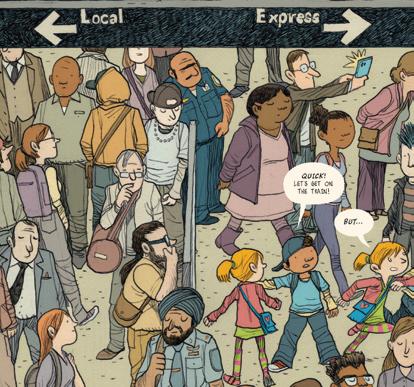
CCSS.ELA-LITERACY.RL.4.4
Determine the meaning of words and phrases as they are used in a text, including those that allude to significant characters found in mythology.
CCSS.ELA-LITERACY.RL.5.4
Determine the meaning of words and phrases as they are used in a text, including figurative language such as metaphors and similes.
u Pay attention to the adjectives used throughout the book. How often do characters use the words “express” and “local”? What do these words mean, and how are they connected to the story and its themes?
The words “express” and “local,” used in reference to the subway trains, provide the plot device that sends Alicia and Pablo out into the city alone. But these concepts also emphasize the difference between Alicia and Pablo. Note that Pablo accidentally drags Alicia and himself onto the express train, and then Alicia puts them back on the local. Alicia is a city “local”—she knows every detail and every stop of the city subway system. Pablo, by contrast, is on the “express” track, jumping from city to city, frequently skipping stops. In the end, they have the makings of a good friendship, partly because of these differences. Like the subway’s local and express tracks, Pablo and Alicia each have their own unique speeds and personalities, and both have a place in the city.
u How often do the characters use the words “lonely” and “friend?” What do these words mean, and how are they connected to the story and its themes?
Alicia is the character most associated with the word “friend.” From their first meeting, she is eager to become friends with Pablo (page 9). She can’t understand that Pablo might want to be alone (pages 28-29). Pablo, by contrast, is the character most associated with the word “lonely.” On the second page (page 8), his mother worries that he will be lonely at school. Later, Alicia expresses it several times (pages 25, 27, 29), and Pablo finally articulates it himself on page 31 (“this is the loneliest…I’ve ever felt). But, at the end of the story (page 35), it is Pablo himself using the words “friend” and “home.” Pablo, in other words, learns to see that friendship is a precious tool for surviving in a fast and confusing environment. This speaks to the nature of New York City, which takes in many outsiders and people from different backgrounds. The city can be both inclusive (friendly) and exclusive (lonely), sometimes even at the same time.


u What does “friend” mean in the story? How does having friends make you feel? How do you make new friends? Is it different from the way Alicia and Pablo become friends?
Making friends means creating interpersonal connections and developing interpersonal attachments. As Pablo discovers, we almost always need to feel secure and confident in order to truly open ourselves up to others and make friends. Friends help you expand your world and enrich your life. Just as Pablo and Alicia’s different attitudes and experiences begin to work in dialogue with each other, new friends can introduce each other to a wide range of ideas.

CCSS.ELA-LITERACY.RI.4.6
Compare and contrast a firsthand and secondhand account of the same event or topic; describe differences in focus and the information provided.
CCSS.ELA-LITERACY.RI.5.6
Analyze multiple accounts of the same event or topic, noting important similarities and differences in the point of view they represent.
u What does the word “lost” mean to you? What are some different ways that the characters are “lost” in this story?
Although the characters are literally lost in the subway system, Pablo experiences loss in other, more emotional ways as well. As someone who’s had to give up his home several times, he arrives in NYC already lost. He feels that he has no connection to other people, and no control over his life (hence all the “whatever”s). When he finds his way, he also finds the confidence he needs to turn around his attitude about New York. Ask students about moments they have been lost, both literally and emotionally, and what tools they used to find their way.
The City
u What does New York City mean in the story? What does it mean to you? What do you think the city meant to the author/illustrator? Note that the author is a New Yorker, while the illustrator is not from New York (he comes from Spain).
The concept of a “city” in our mind is established from our own memories and experiences, therefore it differs from one person to another. But students will likely draw on some similar descriptors: big, fast, crowded, dirty, exciting, dangerous, etc. Ask them to find moments in the book that reinforce these impressions. If your students live in New York, ask them if they recognize the city as it is portrayed in this book. If they don’t live in New York, have students describe their own city or town. How do they think it might look to an outsider? What would they show a stranger in order to help them feel comfortable there?

u In the final moments of the story, Pablo declares that New York is “beginning to look a lot like home.” What does “home” mean to you? What does it stand for? What would this term mean to someone who has moved a lot?
Home is often something that we have to find for ourselves. Part of growing older is learning to build “homes” in new environments (this is something that young people have to learn the hard way if they move to a new school). A home is much more than a place, it is really the feeling of comfort and community. In some ways, it could be seen as the place that guarantees the first four levels of Maslow’s hierarchy of needs—it’s a place of safety and nourishment, a place of community and family, and a place where you feel happy and confident.
2 Visual Expression
CCSS.ELA-LITERACY.RL.4.7
Make connections between the text of a story or drama and a visual or oral presentation of the text, indentifying where each version reflects specific descriptions and directions in the text.
CCSS.ELA-LITERACY.RL.4.5
Explain major differences between poems, drama, prose, etc. Refer to the structural elements when writing or speaking about a text.
CCSS.ELA-LITERACY.RL.5.7
Analyze how visual and mulitmedia elements contribute to the meaning, tone, or beauty of a text
CCSS.ELA-LITERACY.RL.5.5
Explain how a series of chapters, scenes, stanzas, etc. fits together to provide the overall structure of a story.
CCSS.ELA-LITERACY.RI.5.4
*The standards listed on the right are fulfilled by every question in this section. Additional standardsmaybelisted in the gray sidebar on the left for particular units listed below.
CCSS.ELA-LITERACY.RI.4.4
Determine the meaning of general academic and domain-specific words or phrases in a text. (Here, art and comics vocabulary)
Word Balloons

CCSS.ELA-LITERACY.RI.4.7
Interpret information presented visually, orally, or quantitatively (e.g., in charts, graphs, diagrams, time lines, animations, etc.) and explain how the information contributes to an understanding of the text.
CCSS.ELA-LITERACY.RI.5.7
Draw on information from multiple print or digital sources, demonstrating an ability to locate an answer to a question quickly or to solve a problem efficiently
Determine the meaning of general academic and domain-specific words or phrases in a text. (Here, art and comics vocabulary)
u The artist utilizes a variety of styles to express the tone of sentences and words—using bold, italic, all caps, and larger sizes. Give several examples of each category, and compare them. Note that the largest font is used on pages 34-35, where Alicia and Pablo are reunited. Why do you think this might be?
Comics lettering is integral in determining how the reader interprets the emotions of the characters. Large, or loud-looking fonts can express both happiness and frustration, so we have to use other information (context clues and facial expressions) to complete the emotional picture. The reunion on pages 34-35 is a happy one, and marks the true climax of the narrative.
u Sometimes, there are more than just words in the word balloons. Look at page 16, where a diagram of the subway track is included in the first word balloon. Compare this word balloon with the overall composition of pages 16-17.
The word balloon is almost a miniature version of the 2 pages (which also show the express and local tracks). In the diagram, however, the division between local and express systems is rendered very clearly so the reader can understand the subway system construction. Ask students to compare this diagram with the cut-away illustration on page 45 (in the index). They will note that the diagram on page 16 is 2 dimensional (x and y axis, side-to-side and forward-and-backward) whereas the illustration on page 45 introduces a z axis (up-and-down).


u Compare the diagram on page 16 to an architectural floor plan (see left). What are some similarities and differences between the two?
Explain to students how important it is for architects to first develop a floor plan or blueprint, so that they can execute the design. This was true in the construction of the subway, but it’s also true for the construction of a drawing, or book. Have the students look at pages 43 and 46, where they can find earlier drafts of the artist’s illustrations. How do these sketches compare with blueprints?
u Word balloons are both artistic and functional. Look carefully at the balloons on pages 12-13, 1415, 26-27, 28-29, and 30-31. What do you see? Describe how the word balloons on these pages differ from one another. Pay attention to role of balloons in “guiding” the eye of the reader.
Word balloons often help guide the movement of the reader’s eyes to follow the action of the story. This is especially important in this story, because the word balloons help the reader from getting lost in the dense urban landscapes, busy crowds, and quick actions of the adventure. On the aforementioned spreads, students may note that the balloons help guide the reader across physical space in a single scene (pages 12-13), through different events in time (pages 14-15), and in and out of traffic (pages 26-27, 28-29, 30-31).

Panels

u Note there are several kinds of panels in the book. We see, for example, loose panels without any border or outline (pages 8-9), clearly defined grids with white space (also called a “gutter”) (pages 30-31), or pull-out panels in lined boxes (pages 36-37 and pages 40-41). What do you notice about these panels—how are they similar, how are they different?
These different types of panels each play with the relationship between unconfined and confined space, openness and closure, as well as the relationship between colors. On pages 8-9, the free-handed panels give an energetic but disorganized impression (matching the emotions of the characters); on pages 3031, the straight-cut panels resemble lines on a map, soundlessly limiting Pablo’s movement among the panels (except where his body breaks into the gutter as he lands on the 6 train). Pages 36-37 and 40-41, by contrast, are designed to highlight the difference between emotional character interaction (the scenes in the panels) and background setting (the large image behind the panels).

Color

u Note the unique panel design of pages 24-25. What do you see? Have students explain the dual role of the gutter/white space in the composition.
In this image, the gutters also serve the function of subway poles. If your students are from New York and are familiar with subway poles, let them talk about it. If your students are from outside of New York, compare the MTA’s subway car interior with your local subway or bus interiors. By filling a dual function as dividers and as a part of the scene, these panel borders actually add 3-dimensionality and depth to the image (such as when Alicia’s ponytail appears in front of it).
u Look at the color palette of the book. Is it consistent? Does it change from scene to scene? Compare the color of the characters and backgrounds and describe any similarities and differences. Why did the artist make these choices?
The color palette of the book is mostly consistent. The background appears un-saturated (meaning it looks somewhat gray). The central characters, by contrast, are brighter, more colorful, and more-saturated, so they stand out from their environment. This is done for two reasons—first, to direct the eye to the figures and, second, to communicate the artist’s interpretation of New York City as a place that may appear cold, but is actually filled with human warmth. Students may be interested to note that the colorist of this book is Lola Moral, the wife and long-time collaborator of the artist Sergio García.
u Take a look at the colors used for each of the subway lines. List the different shades used by the MTA system and describe how these colors make you feel (or what they make you think of). If you live in NYC, which subway line is your favorite, and why? If not, which color is your favorite, and why?
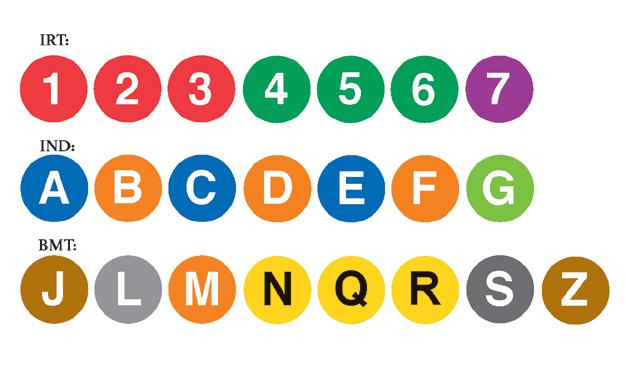
Colors have their own characteristics and are scientifically proven to have effects on human psychology/behavior. Colors also have their own unique cultural and social meanings. They also can be quite subjective, so while patterns may emerge, it is not uncommon for each individual to respond differently to a particular color. The study of these phenomena is called Color Psychology and has been around for hundreds of years. Students may enjoy building a chart of colors and their social meanings (such as black—death, green—envy (or “go”), red—love (or “stop”), yellow—happiness, etc.). Then have them reflect on their personal feelings about colors.
CCSS.ELA-LITERACY.RL.4.3
Describe in depth a character, setting or event in a story, drawing on specific details in the text (e.g., a character’s thoughts, words, or actions).
CCSS.ELA-LITERACY.RL.5.3
Compare and contrast two or more characters, settings, or events in a story, drawing on specific details in the text (e.g., how characters interact).
u What are the personalities of Alicia and Pablo? Do the colors of their clothing reflect their personalities? Why or why not? What is your favorite color to wear and why? Do you feel like you’re free to express who you are through what you wear? Are there clothes or colors that you are not supposed to wear? Why or why not? Would you like to see those rules change?
Have students refer to their charts on colors and their social meanings. What associations do we have with the colors blue and yellow (Pablo) or pink and green (Alicia). Some students may note the gender stereotype in assigning blue and pink to these characters respectively. Engage students in a discussion of gender and color and let them share their thoughts without any judgments. Aside from gender, do the colors fit the characters’ personalities?

u Pablo and Alicia each have their own color palette, and this palette has a subtle effect on the background. Note on pages 28-29, for example, where Alicia is the main character, how the pink color of her clothes is echoed in red umbrellas, the red Macy’s logo, red lips, and a red soda ad. The yellow/ orange of her hair is echoes in the taxi cabs and several rooftops. On pages 30-31, by contrast, Pablo is the main character, so a bluish color fills the spread (with blue subway seats, blue sky and green 6 train sign). What does this communicate to the reader?
The city, much like color, is quite subjective, so it is not surprising to see a different color palette for “Alicia’s New York” and “Pablo’s New York.” Note that Alicia’s New York is also very crowded (with many friends or couples—including a pair of dogs!). Alicia, as discussed, is more relationship-oriented, so her vision of the city is focused on people.
u The appearance of the solid blue/grey sky differs from page to page. Find every page in which the sky is visible and describe what it looks like (how it is framed and what color it appears). What is the function of the sky, visually?
CCSS.ELA-LITERACY.RL.4.2
Determine a theme of a story from details in the text; summarize the text.
CCSS.ELA-LITERACY.RL.5.2
Determine a theme of a story from details in the text, including how the characters in a story or drama respond to challenges; summarize the text.
The sky can be understood as a metaphor/symbol of openness, and is set in contrast to the subway (which is “closed” and “underground”). Visually, the sky allows the illustrations to “breathe,” and changes our sense of the city’s density. Compare pages with sky (page 30) to pages without sky (page 31). Note that the color of the sky changes as the story progresses, following a realistic progression from morning to afternoon. Students may also note that we see a great deal of sky at the end of the book. The large sections of sky toward the end of the story do more than indicate the students’ journey upward to the viewing platform of the Empire State Building. They also metaphorically reinforce the feeling of hope, confidence, and freedom that Pablo feels after his adventure in the city.
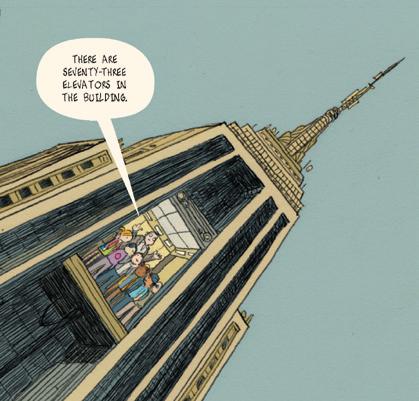
Composition & Space

CCSS.ELA-LITERACY.RL.4.2
Determine a theme of a story from details in the text; summarize the text.
CCSS.ELA-LITERACY.RL.5.2
Determine a theme of a story from details in the text, including how the characters in a story or drama respond to challenges; summarize the text.

u The story is read from left to right, and the pages flip from right to left. Keeping this in mind, take a look at the following question: Which direction do Pablo and Alicia generally face? How is that relevant to the progress of the story? Can you tell the difference between situations in which Pablo faces right from situations in which he faces left? What about the scenes when he faces out, directly at the reader?
In this story, as in most comics, facing right generally means “looking or moving forward.” Facing left generally means “being held-back, encountering an obstacle, or being difficult.” On pages 7-11, Alicia typically faces right while Pablo faces left. When Pablo faces the reader, however, it is usually a sign of one of two emotional states: retreating into himself and his feelings (page 9) or opening up to people (page 42). In real life as well, opening up and retreating into yourself can be seen as two sides of the same coin. They both require a moment of pause, some introspection, and an honest examination of feelings.
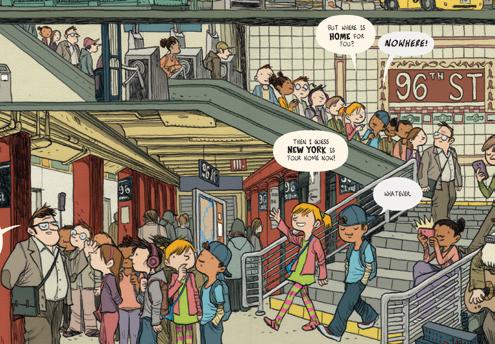
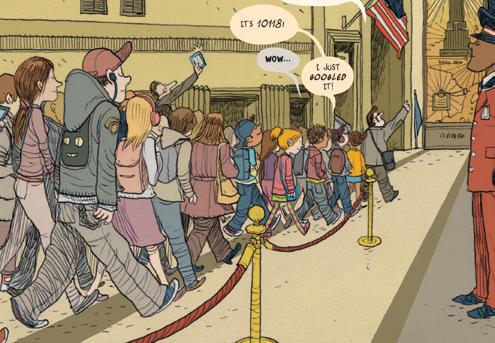

u Draw a diagram of the movement of characters within each page spread. Because the subway system is underground (and the Empire State Building is above ground), much of the movement may be categorized in terms of moving down or up. How does the visual movement of each page match the narrative movement of the story?
Note the downward movement on pages such as 14-15, versus the upward movement in pages such as 36-39. Although the characters are literally moving “up” at the end of the story (to the Empire State Building), the movement is metaphorical as well. Pablo is breaking up out of the confines of his attitude and reservations and is starting to realize how promising and positive his life can be. He even starts to open himself to Alicia and the idea of a “friend.” Positive attitudes are strongly connected with upward movement (at least metaphorically).
u In several scenes, the movement of the characters is split within a single spread. In many cases, the architecture of the subway or city helps to keep the action separate. Take a close look at your diagrams for these pages (especially pages 18-19 and 26-27). How did the artist use the background environment as a kind of division to emphasize opposite movements?
These scenes are very important, because they mark moments in the story where characters get lost, or separated from one another. The artist underscores the way in which the city itself contributes to this range in direction. Truly, anyone who has tried to find their way within the New York subway knows that the entire system is built on the idea of people moving in many different directions at the same time. Just look at the rendering on page 45 of the index!
CCSS.ELA-LITERACY.RL.4.3
Describe in depth a character, setting or event in a story, drawing on specific details in the text (e.g., a character’s thoughts, words, or actions).
CCSS.ELA-LITERACY.RL.5.3
Compare and contrast two or more characters, settings, or events in a story, drawing on specific details in the text (e.g., how characters interact).
u There are many arrows and indicators within the visuals themselves (especially the subway signs). Why do they exist, from your point of view? How do they play a role in guiding readers and marking the progress of the story?
Students should note pages 16-19, where the arrows on the subway signs both foreshadow and explain the way in which Pablo and Alicia become separated from the group.

u Take a look at the perspective in each of the spreads, and identify the “vanishing point” of the image (see left image). Where do the characters move “in” to the vanishing point and where do they move “out” toward the reader? How does this make you feel?


Almost every spread has elements that move both in and out. On page 8, for example, the center panel is directed “in” (the movement recedes into the “vanishing point). In the upper and lower panels, however, the action is directed outward, toward the reader. Note that these images still have a left to right movement overall, which is necessary to guide the reader from panel to panel. An even more complex example is on pages 26-27, where both Alicia and Pablo move toward the reader, and then recede back into the vanishing point (one above ground, and the other below). In your discussion of perspective, students may be interested to note pages with unusual perspective (such as pages 32-33, with a 2-dimensional map, or 22-23 which has a downward-facing perspective).
u Take a look at the perspective and movement on pages 38-39. Do you find this page impressive? Why or why not? How does the visual composition contribute to your feelings and reflect the narrative of this part of the story?
Pages 38-39 move upwards into the vanishing point of the sky. This is one of the few pages at this angle, so it catches our eye with its unique structure. The design emphasizes upward, hopeful movement, which matches the positive attitude shift on the part of the protagonists. Potential drawing exercise: recreate pg.38+39 based on the text. As a potential drawing exercise, you can ask students to recreate this page with a different design. Are there any other elements/things they think might supplement this page? Is there anything that could be removed from the composition? Why or why not?

CCSS.ELA-LITERACY.RI.4.5
Describe the overall structure (chronology, comparison, cause/effect, problem/solution) of events, ideas, concepts, or information in a text.
CCSS.ELA-LITERACY.RI.5.5
Compare and contrast the overall structure (chronology, comparison, cause/effect, problem/solution) of events, ideas, concepts, or information in two or more texts (or parts of a text).
Time
u After the three spatial dimensions, time is considered the fourth dimension. How do you perceive the progress of time throughout the story? Come up with examples, and elaborate.
The passage of time is a deeply important part of comics story telling. Ask students to find different ways that the artist shows the passage of time. Compare pages 11, 20-21, and 34-35. On page 11, different moments in time are assigned separate panels, and the word balloons help guide us through time. On pages 20-21, the same is true, but we see two parallel and simultaneous narratives on a single spread. On pages 34-35, which, like most of the book, are drawn without panels, the key figures are drawn multiple times within the spread to indicate movement through time and space.
u The progress of time in the story ties in closely with the sub-story of Sergio and the Cop (see index, page 43). What is the story between these two characters? What do you see? How is their story similar to or connected with the story of Alicia and Pablo?
The narrative of Sergio and the cop is a great mirror to Alicia and Pablo, because they also begin in conflict and end in friendship. Their dynamic yet consistent appearance also functions as a helpful indicator that guides readers through the story.
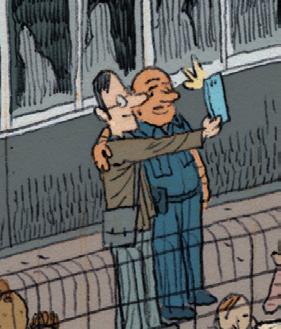
u Examine pages 24-25, where each of the 7 slim panels pushes time forward bit by bit. Because the scene remains consistent, each of the panels is like a frame of a movie. What are the differences from panel to panel?

This is a potential drawing exercise or learning opportunity: let students create artworks based on the idea of different frames from a single “long shot” (you may wish to utilize a phone or camera) to record a continuous movement of their classmates and then break it down into still moments. How many frames do you need to clearly illustrate a minute in time?
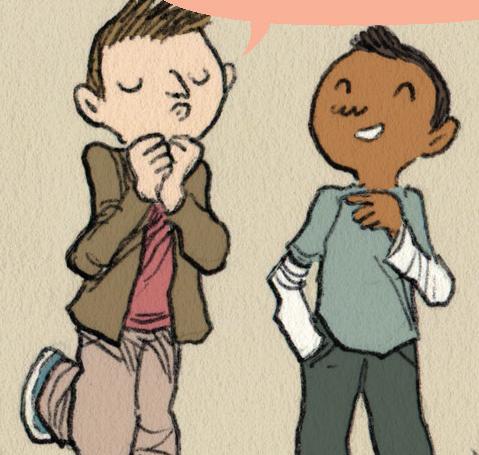
u Are there other characters whose stories we can track throughout the book? Take a look at Charlie, the boy who mocks Pablo on page 9. What happens to this character over the course of the story? What about the old loving couple that first appear on page 22? Follow their interaction and describe their relationship. Use your imagination to make up a story for Charlie and the old couple, and share your thoughts with your classmates.
As Scott McCloud said in his TED Talk on Comics, “there’s also a balance between the visible and the invisible in comics. Comics is a kind of call and response in which the artist gives you something to see within the panels, and then gives you something to imagine between the panels.” The evolving, but somewhat hidden stories of these side characters draw attention to the very real passage of time that takes place in comics storytelling.

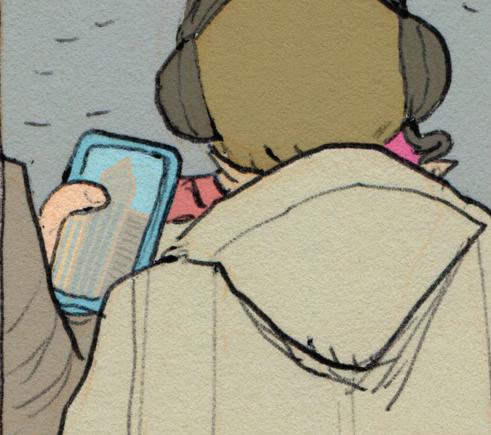

*Find more on Scott McCloud’s TED talk: http://www.ted.com/talks/scott_ mccloud_on_comics?language=en
Symbols
u The teddy bear is given to Pablo by his mother on page 8. What is the significance of the teddy bear in this story? Relatedly, what is the significance of holding hands? This is something that Pablo’s mother attempts on the first page, but that Pablo resists until page 41, when it solidifies the friendship between him and Alicia. What does hand-holding mean for you? What emotions are associated with hand-holding? What emotions are associated with having a stuffed animal? How are these connected?
The teddy bear is a symbol of Pablo’s mom and her love for Pablo, and it is also a more general symbol of affection and attachment. The same can be said about hand-holding, and Pablo’s resistance to both is indicative of his anxious avoidance of attachment. Ask students to interpret Pablo’s emotional history and difficulties based on his responses toward affection. Why does Pablo want to be so independent? Encourage a variety of interpretations—early adolescent desire for independence, frustration about moving so often, feelings of insecurity, etc. This discussion will tie in well with the earlier discussion of Pablo’s character and self-confidence in the Verbal Expression section.
u There are many mobile devices throughout the illustrations. In some cases you can even see what is on the screens. What do they depict? Is there a specific message the illustrator wanted to express?
The shared use of mobile technology, even across a diverse group of people, indicates the commonality and shared experience between people (especially within the same city). This shared commonality is underscored by the fact that many devices display the Empire State Building on their screens. The Empire State Building is used as a symbol for freedom, unity, and friendship, which we can understand as an example of a “shared value.”
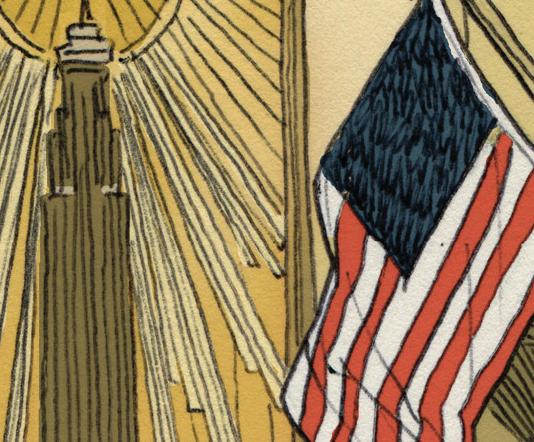
CCSS.ELA-LITERACY.RI.4.1
Refer to details and examples in a text when explaining what the text says explicitly and when drawing inferences from the text.
CCSS.ELA-LITERACY.RI.4.2
Determine the main idea of a text and explain how it is supported by key details; summarize the text.
CCSS.ELA-LITERACY.RI.4.3
Explain ideas or concepts in an informational text, including what happened and why, based on specific information in the text.
CCSS.ELA-LITERACY.RI.5.1
Quote accurately from a text when explaining what the text says explicitly and when drawing inferences from the text.
CCSS.ELA-LITERACY.RI.5.2
Determine two or more main ideas of a text and explain how they are supported by key details; summarize the text.
CCSS.ELA-LITERACY.RI.4.3
Explain the relationships or interactions between two or more ideas or concepts in an informational text.
u From your point of view, what defines the United States and makes it unique? What makes us all “Americans?” What are the things that come to your mind when you think of United States as a country? Look at the American flags in the illustrations. Find out how many American flags are depicted in the book? What does it stand for? How do you view the American flag?
National flags are meant to represent the spirit of the country. In the case of the United States, it celebrates the unity of independent states under a single national vision. This unity through diversity can be seen in many aspects of the book. The flags are placed prominently in the book from pages 35-42, and guide the movement of the characters to the top of the Empire State Building (where friendship, or unity, blossoms between Pablo and Alicia—as well as between Sergio and the Cop). Students may be interested to connect this visual subtext with the verbal idea of “friend” and “home” that are underscored on the final pages of the story.
Representation of Reality
u How does this book represent “New York City?” Name the iconic buildings, landmarks, or famous things you think of about New York City and reflect on how, or if, they are represented in the book. What impression of New York City do you get from reading this book?
Make sure to draw attention to the iconic imagery featured in this book—the NYC taxi, news stand, and subway performer on pages 14-15; the punk guy on page 19; the Keith Haring graffiti on pages 20-21; the NYFD fire truck and Times Square signage on pages 26-27; the NYPD, Macy’s, and Yankees logos on pages 28-29; the Superman patch on page 30. This might be a good time to point out all the inside references that are visible in the background advertisements. The artist included many allusions to TOON Books & Graphics, its predecessor RAW Magazine, and Art Spiegelman’s book MAUS (first published in RAW) (pages 2627). On page 36, you can also see one of the artist’s own famous characters (with Mickey Mouse hair) on the side of a bag.


u Look at the people in the illustrations. What kind of variety can you find in terms of gender, age, race, religion, and body type? From your personal experience, do you think this depiction is realistic? Why or why not? How does this depiction compare to other books or comics?
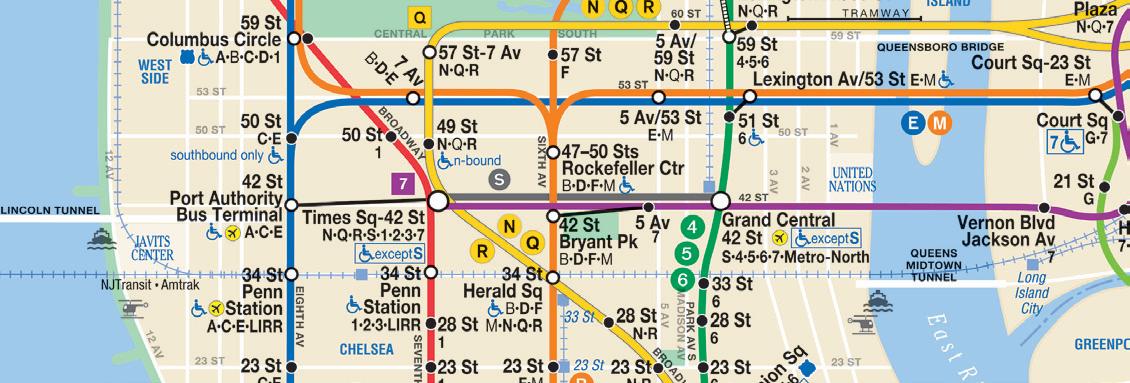
3
Further Research
CCSS.ELA-LITERACY.RI.4-5.9
Integrate information from several texts on the same topic in order to write or speak about the subject knowledgeably.
CCSS.ELA-LITERACY.W.4-5.1
Write opinion pieces on topics or texts, supporting point of view with reasons and information.
CCSS.ELA-LITERACY.W.4-5.2
Write informative/explanatory texts to examine a topic and convey ideas and information clearly

CCSS.ELA-LITERACY.W.4-5.3
Write narratives to develop real or imagined experiences or events using effective technique, descriptive details, and clear event sequences.
CCSS.ELA-LITERACY.W.4-5.7
Conduct short research projects that build knowledgfe through investigation of different aspects of a topic.
u There are a few different maps in the book. Compare them, noting the similarities and differences. How do the hand-drawn maps differ from the MTA subway map printed on the front endpages of the book? Compare the map in the book with maps of New York from different time periods, or old subway maps. Refer to the index for the history of NYC subway system. Create your own map of NYC or your hometown! Present your map to the class and explain how it is unique.
u Choose one or two of Alicia and Pablo’s classmates that we meet in this story. Write a version of the day from their perspective. Use all information from the text that you can find about these other students. Find moments where your story “crosses paths” with the one in this book.
u Writing Project: choose any of the questions from the Verbal or Visual Expression sections. Write a short piece explaning your answer clearly, using reasons and evidence from the text.
u Readers Theater: read various scenes aloud in class. Pay attention to their inflection. If possible, try out multiple roles and be sure that you adjust your performance accordingly. Try to incorporate visual information from the images into their performance. Have fun!
